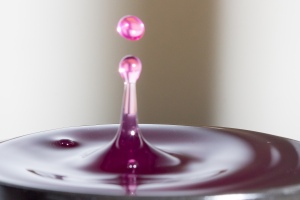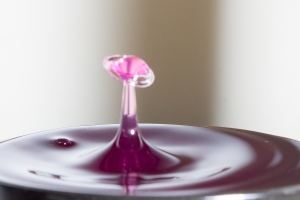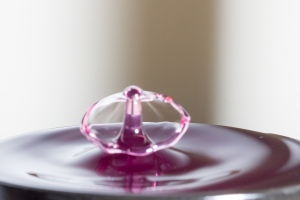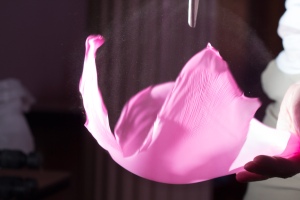At our May 17th meeting, we had a presentation by Maurice Ribble on high-speed photography. Maurice discussed the history of high-speed photography, which was originally developed to enhance scientific research, but morphed into an artistic endeavor. Next, he explained to us the somewhat counter-intuitive basics of photographing objects moving at high speeds. A camera on a tripod with a remote control for the shutter. Okay, I probably could have figured that out. What about lighting? I would have lit the room up like crazy. After all, I’d use the fastest shutter speed I could to freeze the motion, right? I’d want a lot of light, right? Wrong. The key to capturing the split second a balloon bursts is not the shutter speed. It’s the flash that freezes the motion. So, low light, not so fast shutter speed. Who would have thunk?
Okay, so if we have our low-light setting, our flashes set up, and the proper shutter speed, just how do we capture the precise moment when a water droplet rebounding from the water’s surface collides with the next droplet falling from the sky? Enter the Camera Axe, a device that Maurice developed to help increase the accuracy and reproducibility of high-speed photography. Instead of endless attempts to squeeze a water droplet from an eye dropper and a camera’s remote trigger at precisely the right moment, we could use the Camera Axe, a device that can be linked to visual and audio sensors and to trigger the camera and multiple flashes. For example, you could set up a visual sensor that detected the movement of an object, like a bullet, and then trigger the camera and flash.
Maurice finished his talk with some great photos of objects being blown apart by pellets from an air gun. Images included colorful Crayola crayons, Jello-filled Christmas ornaments, and eggs at the moment of impact. He also shared photos of birds frozen in flight. The pictures were so precise that you could practically count each feather on the bird.
After the talk, we had an opportunity to experience the principles of high-speed photography first hand. Maurice jerry-rigged a setup of PVC pipes, a camera, flash units, a valve with a sensor holding colored water thickened with liquid soap and guar gum, a audio sensor, a cup of water, and the Camera Axe. First, we captured water dropping from the valve into the cup below. If I understand it correctly (and that is a big ‘If’), the sensor on the valve lets the Camera Axe know when a drop is falling and the Camera Axe is programmed to trigger the camera and flash. The Camera Axe software program lets you control the lag time between the drop’s release and triggering the camera. After a few quick adjustments, we were in business. And here is the result.
Our finally experiment of the evening was popping balloons. See what you are missing when you can’t make meetings! 😉
Using an audio trigger, which nearly blinded me as we laughed and chatted while Maurice blew up balloon after balloon, we popped a few balloons and were able to capture the moment it burst.
We had a really great time and I think everyone is know excited to try some high-speed photography of our own.
Looking forward to seeing you all at the June meeting. Also, feel free to comment and correct anything. I was too enthralled to take serious notes.




